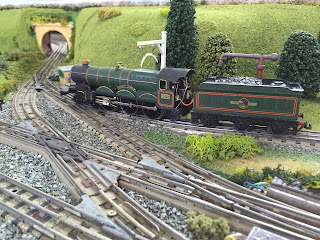At the Bridport exhibition, two locos failed. Sadly they were also two of the locos that have been worked on recently!
St Paddy arrived earlier this year, minus a bogie but during its first outing in Yeovil it was found to be seriously down on power. Such was my desperation to see it run, I swapped the chassis with the green deltic, and then never swapped it back. So technically it's the green deltic that's faulty and not this one.
Initial thoughts were that this was a simple wiring fault as it showed no sign of life and no current consumption. In reality the wiring was probably the only thing that was actually alright.
Once stripped and checked on the bench, I had to resolve the following:
- Stuck carbon brush
- Dirt / grease build up on armature commutator segments
- Excessive carbon between commutator segments
- Brush tube too far away for carbon brush to make contact with armature
- Bottom armature bearing spinning in cast
- Tyre missing
The lower bearing was glued back into position, there doesn't seem to be much movement with the armature in position and does explain the alarming clattering noise that this chassis has always made!
The other faults were fixed relatively quickly and the loco has now been returned to the stock box ready for the next show.
Atholl was more of a challenge. It was a real disappointment that this one wouldn't run properly and with current consumption of 0.75 amps, this is far too high and would only lead to the inevitable burnt out armature if left. This is the beauty of having ammeters installed on the layout - it can alert you to problems before they become major issues. It's also handy when using feedback controllers as I do, as the controllers tend to increase the power when needed and can hide issues such as these.
With the body removed, I took out the armature and found nothing wrong with it. The problem was with the valve gear and connecting rods - too much rolling resistance and not easy to turn by hand, that explains the high current consumption. I'd previously had issues when I refitted everything to this loco with the rod pins falling out. I'd removed all the valve gear when I painted the front assembly. Under better light it became clear that I wasn't the first person to have removed the valve gear and traces of glue could be seen around the holes of the rod pins. The pins themselves appear to be fine, some of the holes however are more oval-shaped. Presently I have no real way to repair this and I'm not keen to glue it.
I decided to do a chassis swap. I have a Duchess of Sutherland, a loco that was sold as a poor repaint but at the time, when running on the old layout, actually looked quite decent. Recently it's been omitted from the stock box so I removed its body and rather than removing the valve gear and risk introducing the same problem, I simply rubbed-down in-situ and hand painted the ends.
Both locos are now ready to run as per the picture above... Result!












































